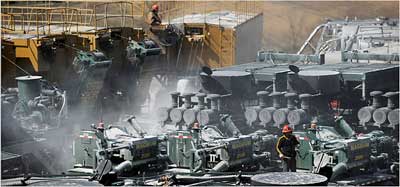HUGHESVILLE, Pa. — At first, Raymond Gregoire did not want to listen to the raspy voice on his answering machine offering him money for rights to drill on his land. They want to ruin my land, he thought. But he called back anyway a week later to hear more.
By the end of February, he had a contract in hand for $62,000, and he pulled together a group of 75 neighbors who signed $3 million in deals.
“It’s a modern-day gold rush in our own backyard,” Mr. Gregoire said.
Kalim A. Bhatti for The New York Times.Property owners at a seminar in Clarks Summit, Pa., on negotiating with gas lease companies.
Jeff Swensen for The New York Times.Fracture drilling workers run machinery on a farm outside of Pittsburgh. Companies are risking big money on rural Pennsylvania, producing billions of dollars' worth of natural gas.
"Across vast regions of the country, gas companies are using a technology called hydraulic fracturing to produce natural gas from previously untapped beds of shale."
Fred R. Conrad/The New York TimesEnvironmental concern about hydraulic fracturing is creating political obstacles for gas drilling companies.
The most immediate hazard from the national drilling bonanza, it is clear, involves contamination of residential drinking water wells by natural gas. In Bainbridge, Ohio, an improperly drilled well contaminated groundwater in 2007, including the water source for the township’s police station, according to a complaint filed this year. After building to high pressures, gas migrated through underground faults, and blew up one house.
Here in Dimock, about 30 miles north of Scranton, Pa., 13 water wells, including that of Ms. Switzer, were contaminated by natural gas. One of the wells blew up.









